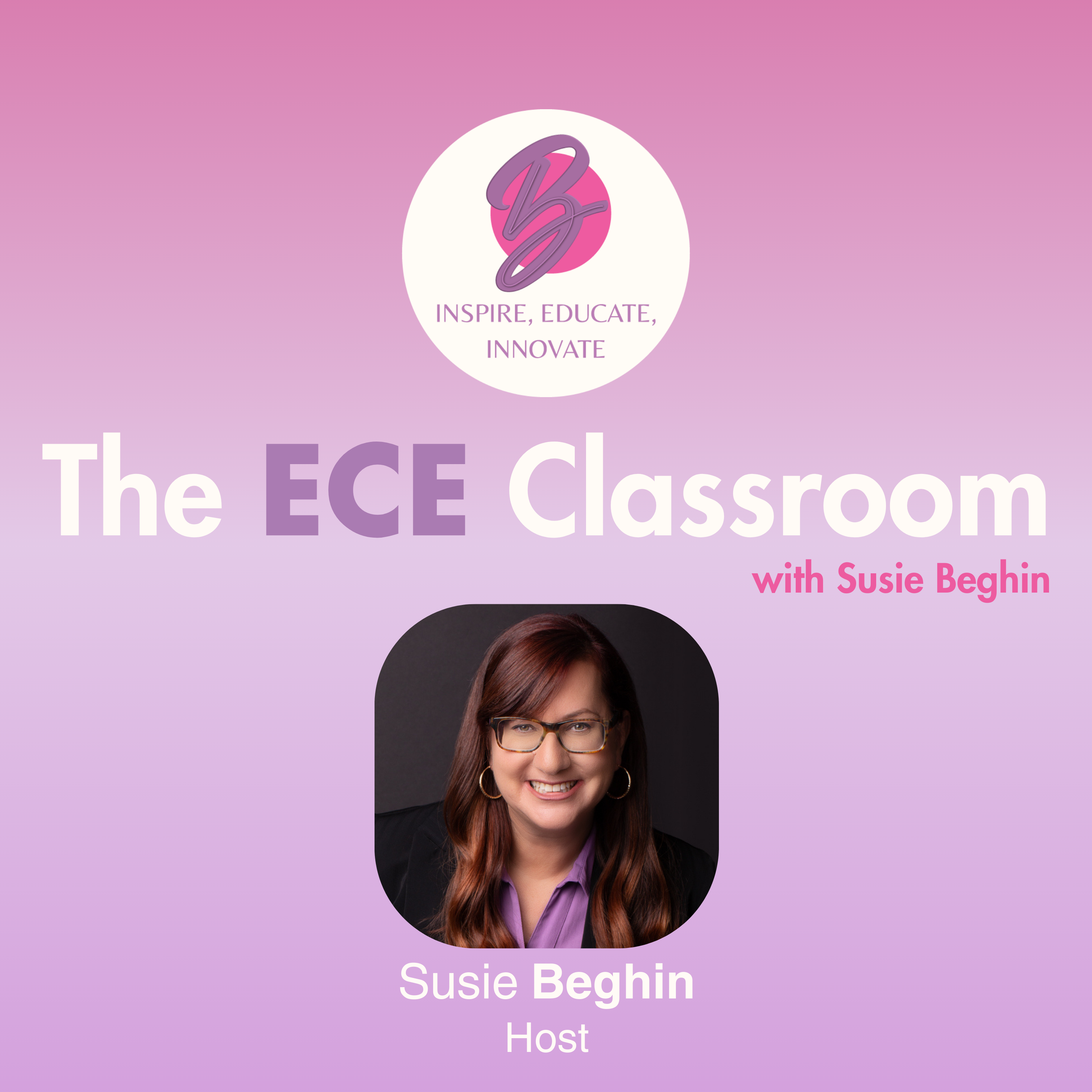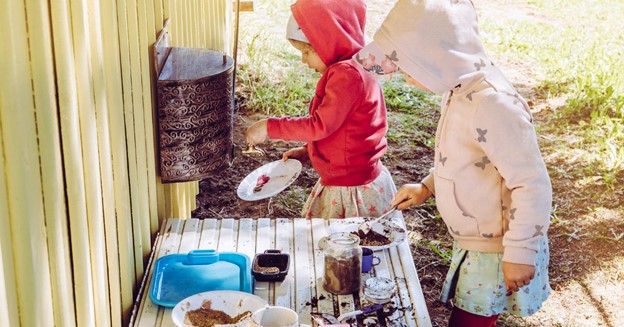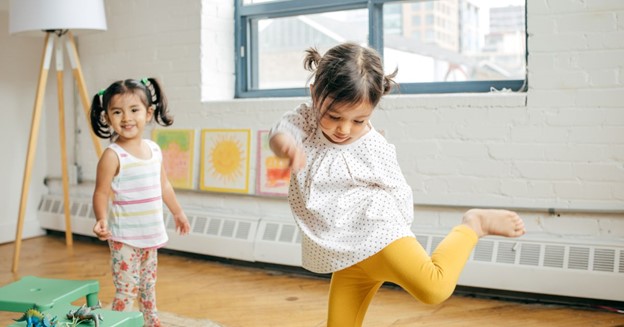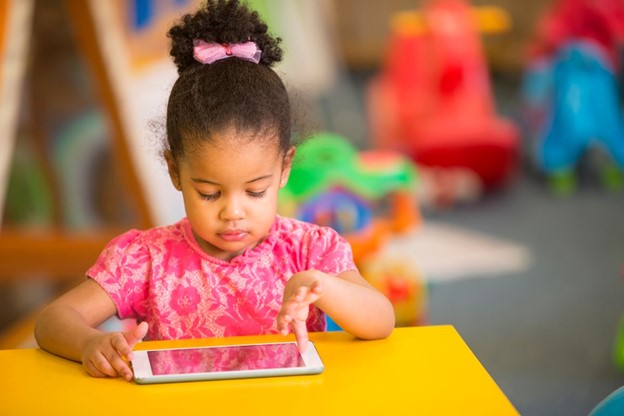The ECE Classroom – New Podcast for early childhood educators
The ECE Classroom with Susie Beghin
by Susie Beghin, RECE, Founder of Alpha’s Discovery Kids
“Educators are the lifeblood of the early child care system.” – Susie Beghin
I am thrilled and excited to announce the launch of my brand new podcast, ‘The ECE Classroom with Susie Beghin.’ Dedicated to exploring key topics in early childhood education, each episode offers insightful discussions and practical advice and is designed to inspire, inform, and empower educators, home care providers, and parents alike. With my background in early childhood education and daycare ownership, I am passionate about nurturing young minds and supporting those who work tirelessly to shape the future generation.
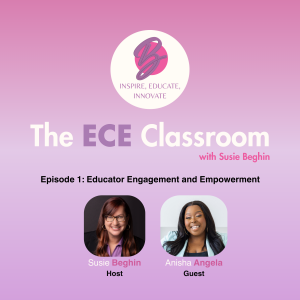
In our inaugural episode, I am delighted to welcome Anisha Angela as our guest speaker. Anisha is an Early Childhood Education (ECE) coach and expert with over 14+ years of experience in the field. Her extensive background includes leadership roles in childcare programs, teaching positions at college programs, and overseeing multiple childcare locations as a senior manager.
As the CEO and Founder of “The Early Childhood Coach + Co,” Anisha is committed to supporting the success of fellow ECE professionals through consulting, coaching, and training. With her wealth of knowledge and experience, Anisha shares invaluable insights into the current challenges facing educators, including burnout and stress, and offers practical tips for reigniting the spark within the classroom.
We hope you’ll join us on this journey of learning and growth as we strive to support and uplift the early childhood education community.
Listen to the podcast here: https://spotifyanchor-web.app.link/e/OPl10EGzNIb
Connect with Anisha on her social channels to stay updated on her insights and upcoming events:
Instagram: @anisha.theecc
Facebook: @AnishaAngella.co
Twitter: AnishaAngella.co (@AnishaAngella)
Youtube: Anisha Angella
Website: www.anishaangellabooks.ca
General Email: info@anishaangellabooks.ca
Spring Adventures for Kids: Exploring Nature
Spring Adventures for Kids: Exploring Nature
by Susie Beghin, RECE, Founder of Alpha’s Discovery Kids
As spring blooms and nature comes to life, it’s the perfect time to engage children in outdoor activities that foster their curiosity and creativity. At Alpha’s Discovery Kids, we’re passionate about providing children with enriching experiences that ignite their love for learning and exploration. From nature walks to mud kitchens, there are endless opportunities for kids to connect with the natural world and unleash their imagination.
Nature walks are a favourite among children and educators alike and are an excellent way to connect children with the natural world while encouraging physical activity and curiosity. During these walks, children have the chance to explore various environments, from wooded trails to open fields, collecting treasures along the way.

Encouraging children to collect items such as pine cones, stones, leaves, and twigs not only sparks their curiosity but also provides materials for creative projects. These collected treasures can be used in art projects, where children can create nature-inspired collages, paintings, or sculptures, fostering their artistic expression and appreciation for the beauty of the natural world. Picking up sticks, in particular, seems to captivate children’s attention as they experiment with different sizes and shapes, imagining them as wands, swords, or tools for building.
Parents can also join in on the fun by taking their children on nature walks in local parks or trails. Equipped with a bag to gather their findings, children delight in the opportunity to explore the great outdoors and discover the beauty of nature firsthand. Nature walks also offer opportunities for hands-on learning experiences. Children can observe different plant and animal species, learning about their habitats, behaviours, and life cycles. Parents can also engage children in discussions about the importance of conservation and caring for the environment, instilling in them a sense of responsibility towards the planet.
Another highlight of outdoor play is the mud kitchen, a beloved feature that encourages imaginative play, sensory exploration and hands-on learning. With simple setups consisting of tables or flat surfaces, pots, pans, and utensils, mud kitchens provide children with endless opportunities to cook, bake, and create. As children mix, pour, and stir ingredients in their mud kitchens to concoct “delicious” meals and potions, children engage in open-ended play that fosters language development, motor skills, and social interaction.
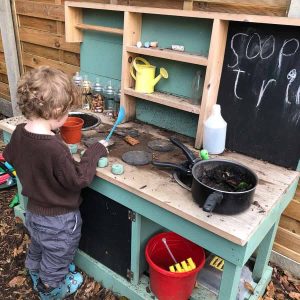
Mud kitchens have benefits beyond imaginative play. As children engage in sensory activities, they explore different textures, smells, and consistencies, enhancing their sensory processing skills. Mixing and stirring promotes hand-eye coordination and strengthens hand muscles, laying the foundation for writing and other fine motor tasks. The sensory experience of squishing mud between their fingers and the freedom to experiment with different textures and consistencies stimulates their senses and ignites their creativity. And, the outdoor setting provides children with the opportunity to engage in physical activity, promoting gross motor skills and overall well-being.
Additionally, mud kitchens offer rich learning experiences that integrate various academic disciplines including our 4 Pillars of Learning. Children naturally engage in scientific inquiry as they observe changes in materials and explore cause-and-effect relationships. Children can integrate elements of mathematics by counting, sorting, and categorizing natural materials or measuring quantities for their concoctions. They also exercise their creativity and artistic skills as they experiment with different combinations and designs, transforming mud and natural materials into works of art.
Whether exploring the wonders of nature on a walk or whipping up culinary delights in the mud kitchen, springtime offers abundant opportunities for children to learn, grow, and connect with the world around them. By embracing outdoor play and nature-based activities, we cultivate a sense of wonder and curiosity that will inspire children to explore and discover throughout their lives.
For more information, visit our YouTube channel for inspiration and ideas.
Winter Activities for Kids: Keeping Kids Active and Engaged
Winter Activities for Kids: Keeping Kids Active and Engaged
by Susie Beghin, RECE, Founder of Alpha’s Discovery Kids
As a mother and early childhood educator, I have witnessed the transformative influence that offering children a well-rounded educational journey can have. And at Alpha’s Discovery Kids, our commitment to giving children the best start in life is embodied in our 4 Pillars of Learning. These pillars, including Language & Literacy, STEAM, Physical Activity & Nutrition, and Mindful Awareness, form the foundation for providing children with the best start in life.
Among these pillars, Physical Activity & Nutrition hold a special place. It’s not merely about keeping young bodies in motion; it’s a holistic approach that nurtures the mind and promotes overall well-being. Even during the winter months, when the cold might tempt us to stay indoors, incorporating physical activity remains key.

Cold weather doesn’t have to mean a halt to outdoor play. At Alpha’s Discovery Kids, we recognize the importance of engaging children in physical activities, even when the temperature drops. The benefits of physical activity extend far beyond the obvious physical advantages. While it undoubtedly promotes physical health by enhancing bodily functions, building strength, and supporting the development of bones and muscles, its impact on mental and emotional health is equally significant. Physical activity has been shown to elevate mood, reduce stress, and foster a positive mindset from an early age.
And although, as adults, we don’t always enjoy heading out into the cold, most children tend to love it! Winter provides unique opportunities for physical activities that are not only enjoyable for children but also contribute to their development. Sledding, snowball fights, and building snowmen are not just recreational; they enhance gross motor skills, encourage teamwork, and promote creativity. These activities keep kids active and contribute to their social and emotional growth.
In addition to outdoor play, indoor physical activities are equally important during the winter. Parents play a pivotal role in encouraging physical activity at home, especially when outdoor play might be limited. On days when heading outdoors is challenging, there are numerous indoor activities that you and your child can enjoy, all with household items you likely already have. Here are a few ideas:
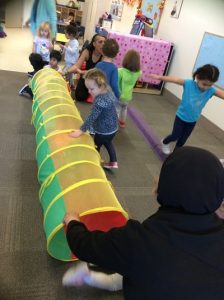
- Magical boxes – Provide your child with a large box and witness its transformation into fire trucks, tunnels, or a fantastic canvas for painting.
- Pillow paradise – Pillows can be more than just for resting. Try crafting an obstacle course or a cozy pillow fort for endless fun.
- Dance party extravaganza – Discover music the whole family enjoys and let loose with a dance party. It’s a fantastic way to get everyone moving and grooving.
- Scavenger hunt quest – Get creative with hiding spots and organize an entertaining scavenger hunt.
- Family flex– Engage in easy stretching exercises suitable for the entire family. It’s a great way to stay active and flexible.
These indoor activities not only keep your children physically active but also incorporate elements from the STEAM pillar (Science, Technology, Engineering, Art, and Math). Building a pillow or blanket fortress enhances engineering skills, and using a box as a canvas introduces artistic elements. Beyond the physical benefits, these activities stimulate young minds and foster a love for learning.
As winter sets in, don’t let it dull the sparkle of your kids’ activity. Integrating physical activity into their routine, even during the colder months, has a profound positive impact. The key is to make it fun and seamlessly woven into daily life. So, let’s embrace the winter wonderland and ensure that, even in the cold, our children are active and engaged.
For more early childhood education tips , check out my YouTube videos.
Holiday Gift Ideas for Toddlers and Preschoolers
Holiday Gift Ideas for Toddlers and Preschoolers
by Susie Beghin, RECE, Founder of Alpha’s Discovery Kids
As the holiday season approaches, parents of young children, especially those with infants and toddlers, may find themselves swept up in the whirlwind and stress of preparations, gift buying, and festivity planning. As a parent myself, I understand that we’re often tempted to rush through the holiday preparations – the shopping, the decorating, and the meal planning – and, in the process, we can sometimes forget the profound significance of being present. The act of slowing down and being fully engaged with our little ones is, perhaps, one of the most special gifts we can offer them.
At Alpha’s Discovery Kids, we’ve always emphasized the importance of presence, and understand the magic of a child’s first few years of life is irreplaceable. These are the years when their brains absorb knowledge like sponges, and their hearts open wide to the love and warmth of family. For parents of young children, it’s a chance to slow down, savor the little moments, and enjoy the glow in their children’s eyes as they discover the magic of the season.
With the constant demands of work and daily life, these special moments with our children are a gift beyond measure. Whether it’s a quiet evening by the fireplace, a snowball fight, or simply enjoying a warm cup of cocoa, focusing on the present moment and embracing the joy of togetherness creates lasting memories.
That said, for many families, the holidays are also a time for gift-giving. But it’s easy to get swept up in the latest toy trends and gadgets. Interestingly enough, it’s often not the flashiest or most expensive gift that young kids want; it’s something that engages their developing minds, encourages creativity, and fosters fun. Being mindful when buying gifts for our children can go a long way in ensuring they are gifts that keep on giving.
So, instead of scrambling to buy the latest fad, consider gifts that align with our 4 Pillars of Learning.
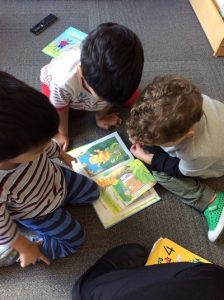
- Language & Literacy:
Beyond age-appropriate books, consider toys like sandpaper letters or magnetic letters that make learning the alphabet an engaging experience.
- Sandpaper Letters: These tactile tools help children connect letters with their shapes, enhancing early literacy skills.
- Magnetic Letters: Perfect for introducing young ones to the alphabet and word-building in an interactive way.
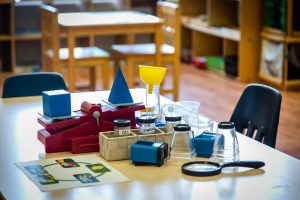
- STEAM (Science, Technology, Engineering, Art, and Math):
With a wide range of options, here are some ideas to explore:
- Science – Magnifying Glass: Spark your child’s curiosity with a tool that opens up the world of exploration.
- Technology – A Digital Microscope: An engaging combination of technology and science, allowing young minds to examine the world up close.
- Engineering – Building Blocks: Wooden building blocks are a classic toy that nurtures creativity and spatial skills.
- Arts – Art Supplies: From playdough to various types of paint and paintbrushes, these tools help children express themselves creatively.
- Math – Math Counters and Math Cubes: Fun manipulatives that make learning math concepts enjoyable.

- Physical Activity & Nutrition:
Encouraging physical activity and promoting healthy nutrition for young children is not only vital for their well-being but also a wonderful gift in itself.
- Riding Toys – These encourage physical activity (whether a bike or a riding car)
- Pretend Play Food: Encourage imaginative play and teach young ones about nutrition with pretend food sets.

- Mindfulness:
You can never go wrong with gifts that encourage mindfulness.
- Be Kind Cubes: These cubes offer a fun way to teach children about kindness and empathy, important attributes that align with the pillar of mindful awareness.
- Sensory materials or tables: The materials encourage children to use their senses and evoke a sense of calm.
Remember, the best gifts for young children are those that nurture their development and foster their growth through the joy of learning through play.
Practicing mindfulness during this season is a gift we offer both to ourselves and our little ones. So, let’s take it slow, savor every moment of this season, and treasure the magic of the present with our children.
For more information on early childhood education topics, check out my YouTube videos or to book a tour, please contact us.
Navigating Cold and Flu Season
Navigating Cold and Flu Season
by Susie Beghin, RECE, Founder of Alpha’s Discovery Kids
As parents, we all want our little ones to stay healthy and happy. However, it’s no secret that young children can be particularly susceptible to colds and the flu. If your child attends daycare, you may have noticed that illnesses seem to make their rounds quite frequently, particularly for those in the 12-18 month age group. This may raise concerns among parents, but it’s essential to understand the underlying cause.
Here at Alpha’s Discovery Kids, we provide an environment where children come together to learn, play, and interact. While these interactions are incredibly valuable for their social and emotional development, they also mean that children are exposed to more germs and viruses than they would be at home.
But believe it or not, this early exposure to various illnesses can be beneficial in the long run. Our immune systems learn by doing. When children are exposed to viruses, their immune systems learn to recognize and fight them off. This exposure helps build their immunity, making them less susceptible to similar illnesses in the future.
Although no parent wants to see their child sick, young children often bounce back from illnesses more quickly than adults. Their bodies are primed to recover swiftly, which means that while they may experience more illnesses, these illnesses tend to be milder and shorter in duration. It’s all part of the learning process their immune systems go through.
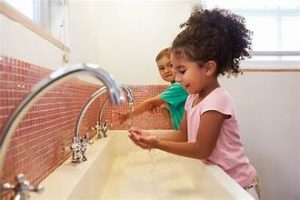
Cold and Flu Prevention
That said, as we approach cold and flu season, there are some things we do at each of our locations to help prevent the spread of illness. One of the most effective ways to minimize the spread of illnesses is through proper hygiene. Hand washing is a crucial practice that we encourage among both children and staff. Our daycare facilities are equipped with sanitation stations, and our dedicated team ensures that children wash their hands frequently throughout the day.
Nutrition also plays a significant role in building a robust immune system. We believe that nutrition plays such a large role in our children’s development that nutrition (and physical activity) is one of our 4 Pillars of Learning, in addition to Language & Literacy, STEAM (Science, Technology, Engineering, Art and Math), and Mindful Awareness. We focus on providing balanced meals and snacks that support your child’s health and well-being, as a well-nourished body is better equipped to fight off infections.
In addition, we maintain open lines of communication with parents. If your child isn’t feeling well, we need to know. By keeping sick children at home, we can help prevent the spread of illnesses within our daycare community.
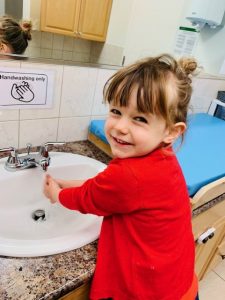
Preparing for Cold and Flu Season
As a parent, there are several steps you can take to prepare for cold and flu season and help keep your child healthy:
- Teach Good Hygiene: Encourage your child to wash their hands regularly with soap and water for at least 20 seconds. Teach them to cover their mouth and nose when sneezing or coughing, ideally with a tissue or their elbow.
- Maintain a Healthy Diet: Provide your child with a balanced diet rich in fruits, vegetables, and whole grains to support their immune system.
- Get Plenty of Rest: Ensure your child gets enough sleep as it plays a vital role in immune system function.
- Consider Probiotics: Some studies suggest that probiotics may help boost the immune system. Consult with your pediatrician or family doctor before adding any supplements to your child’s diet.
- Stay Informed: Keep yourself informed about current health guidelines and recommendations, especially during cold and flu season.
- Get Some Vitamin C and D – Whether it is by natural method (sun/oranges) or supplements, it’s important to get these vitamins.
While it’s common for children to experience more illnesses in daycare settings, it’s part of their natural immune system development. Alpha’s Discovery Kids is committed to creating a supportive and healthy environment for your child, and we encourage parents to partner with us in supporting wellness initiatives. By teaching good hygiene practices, maintaining a healthy lifestyle, and staying informed, you can help your child stay resilient and thrive, even during cold and flu season.
For more information about topics related to the early years, check out my YouTube videos at or to book a tour, please contact us at https://www.alphasdiscoveryclub.com/contact/ .
Unlocking the Wonders of STEAM: Embracing the Power of Math
Unlocking the Wonders of STEAM: Embracing the Power of Math
by Susie Beghin, RECE, Founder of Alpha’s Discovery Kids
At Alpha’s Discovery Kids, we are passionate about providing a nurturing and enriching learning environment where children can thrive.
As advocates of STEAM education, we wholeheartedly embrace the power of Science, Technology, Engineering, Arts, and Math in shaping well-rounded individuals. Our commitment to excellence lies in infusing STEAM concepts throughout our curriculum, empowering young minds with essential skills and fostering a love for learning that lasts a lifetime.
And that’s why we created our unique and comprehensive approach to education, centered around the “The Four Pillars of Learning.” These pillars serve as the foundation of our curriculum, ensuring that every child’s physical, cognitive, social, emotional, and spiritual well-being is nurtured and supported.
The 4 Pillars of Learning consist of Language & Literacy, STEAM (Science, Technology, Engineering, Arts, and Math), Physical Activity & Nutrition, and Mindful Awareness. Each pillar is carefully designed to complement and reinforce one another, creating a holistic learning experience that fosters creativity, critical thinking, and a growth mindset in our young learners.
By embracing these four pillars, we aim to provide a well-rounded education that prepares children not only for academic success but also for personal growth and success in all aspects.
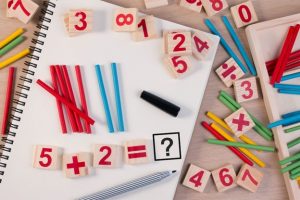
When it comes to Math, it is more than just numbers and equations. Math is a fundamental tool for understanding the world around us. From counting and measuring to problem-solving and critical thinking, math plays an integral role in shaping a child’s cognitive abilities and analytical skills.
Math is an important part of a child’s development from ages 1 to 5 years. During this time, children explore patterns, shapes, sizes, and counting and encounter math concepts in their everyday activities, from counting cars on the road to the number of plates on the table.
However, math can be daunting for both kids and parents. That’s why we believe in teaching math in a visual and hands-on way. For example, when we say 1 plus 1 equals 2, it’s easier to understand when we can see and touch objects to represent those numbers. We want children to experience math in a concrete way, so they truly grasp its concepts.
Math is all around us, and it’s essential to make it approachable and enjoyable for everyone. Some important math skills that we focus on here at Alpha’s Discover Kids include:
Numeracy skills – Skills like counting are among the first things children learn. Many children learn to count from 1 to 10 by age three. We encourage counting everyday objects in a hands-on way to help them grasp the concept. Once children start to understand the concept of counting, you can introduce written numbers so they learn to associate the written form with the concept.
Problem-solving – Another essential math skill is problem-solving, although this can be a tricky concept for many kids. We support children in their problem-solving process without doing it for them. By using number concepts and skills, we help them develop confidence in their own ability to think things through.
Measurement – Measurement is an exciting aspect of math. Children can explore time, weight, distance, length, height, and width in various activities.
Classification – Classification is a fun game where children sort and classify objects based on different characteristics like shape, size, or colour.
To incorporate math into everyday activities, we sort various items into baskets, provide objects to count while filling and emptying containers, and make number figures from play dough. These activities make math a part of their daily fun, helping children build essential math skills while having a great time.
We aim to instill a love for Math by making it accessible, enjoyable, and applicable to the real world. We foster a growth mindset, where children embrace challenges, ask questions, and take risks in their mathematical explorations.
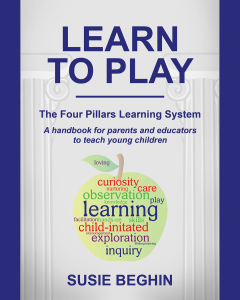
For more information about how to use the Four Pillars of Learning system, check out Susie’s book, Learn To Play: The Four Pillars Learning System on Amazon.
For more information about Alpha’s Discovery Kids, or to book a tour, please contact us at https://www.alphasdiscoveryclub.com/contact/ or call us at 905-823-8257.
Understanding Separation Anxiety: Navigating Emotions and Building Resilience
Understanding Separation Anxiety: Navigating Emotions and Building Resilience
by Susie Beghin, RECE, Founder of Alpha’s Discovery Kids
As a mother of 2 children and owner of Alpha’s Discovery Kids, I am all too familiar with separation anxiety.
Separation anxiety is a normal part of a child’s development, marked by distress when they are separated from their primary caregiver or a familiar environment. During this phase (which usually peaks between 8-18 months), children may become clingy, cry, or show signs of distress when a parent or caregiver leaves their sight.
Although this stage can be especially trying for parents, separation anxiety is actually a sign of a strong bond between the child and their caregiver. It’s also normal for us parents to experience a bit of separation anxiety when we have to leave our child!
At Alpha’s Discovery Kids, we understand the challenges that come with separation anxiety, both for children and parents. Our experienced and caring team is here to provide the support and guidance needed to ease the transition during this phase.
Understanding separation anxiety is the first step towards easing the stress that often comes with this stage of a child’s development.

Communication is Key
Communication is key during this phase. Explaining to our children what will happen while we are apart and when we will return helps them understand that separations are temporary. Showing confidence and trust when leaving them with other caregivers or in new environments comforts our little ones, reinforcing that they are safe and loved.
Empathy and validation of their emotions are vital. Letting them know it’s okay to feel sad or scared when apart and offering words of comfort, reassurance, and understanding assures them that it’s natural to miss someone they love. We are always there for them, no matter the distance.
Establish a consistent routine
As parents, we want to provide the best support for our little ones as they navigate their emotions during separations.
One way to ease separation anxiety is by having a routine. A consistent and predictable routine helps children feel secure and prepared for upcoming separations. By providing comfort and reassurance before leaving and upon returning, your child will have a sense of safety, stability, and reassurance that we will always return.
As you drop off your child at daycare, we encourage parents to let the teachers do what they are trained to do. As difficult as it is to leave, I know from experience that most often, within 10-15 minutes of parents walking out the door, their child will calm down and be distracted by their peers, toys or activities going on in the classroom.
Stay Calm and Patient (and set a positive tone)
Separation anxiety can be challenging for both children and parents. But parents need to understand they are the ones who set the tone. You want this to be a positive experience which means you, as the parent, need to approach separating in a positive way. If you have any negative feelings or apprehensions, your child will pick up on this.
Staying calm and patient during moments of distress is essential for both children and parents. Remember, this phase is a normal part of their development, and will pass with time.
Encouraging their independence in exploring their environment and trying new things builds their confidence, making separations less anxious. And by fostering interactions with other trusted adults and children in safe and enjoyable settings, you can allow these connections to help your child feel secure in various environments.
Provide a familiar item
Building a safe and welcoming environment is another essential aspect. Surrounding our children with familiar objects, toys, or comfort items offers them a sense of security even when they are away from us. Sending your child with a keepsake item that reminds them of you and being at home will make the separation much easier. This item could be a photo, favourite toy or stuffed animal.
Gradual Goodbyes
When it’s time to say goodbye, keep it brief and positive. Prolonged goodbyes can make the separation more challenging for both you and your child. Reassure them that you will be back soon and give them a loving hug or kiss before leaving.
Consistency is essential in helping children feel secure during separations. Try to maintain a regular schedule and routine as much as possible. Consistency can give children a sense of predictability and stability, reducing anxiety.
Seek Support if Needed
Remember, separation anxiety is a natural part of growing up, and with patience, understanding, and support, children can navigate this phase successfully. By offering comfort, reassurance, and gentle transitions, we can help our children develop resilience and emotional security, setting the stage for confident and independent individuals in the future.
Watch our YouTube video for more strategies and support during this difficult time.
At Alpha’s Discovery Kids, we strive to make the transition during separation anxiety as smooth as possible for both children and parents. Through a nurturing environment, consistent routines, and supportive educators, we help children feel secure and confident while their parents are away.
Our focus on building positive relationships, encouraging independence, and offering open communication creates a caring community where children can thrive and grow. With our dedicated team by their side, children can navigate separation anxiety with resilience and emotional well-being, setting the foundation for a positive and fulfilling early childhood experience.
For more information on our 4 Pillars of Learning, or to book a tour, please contact us at https://www.alphasdiscoveryclub.com/contact/ or call us at 905-823-8257.
Unlocking Creativity and Expression: The Essential Role of Art in STEAM Education
Unlocking Creativity and Expression: The Essential Role of Art in STEAM Education
by Susie Beghin, RECE, Founder of Alpha’s Discovery Kids
“Art is about letting go” – Susie Beghin
At Alpha’s Discovery Kids, our mission is to create a nurturing and safe space where every child feels at home. We understand the significance of holistic education, especially during the formative years of early childhood. As young minds develop rapidly, we recognize the importance of providing the best learning environment to support their growth and development.
Childhood is a time of exploration, curiosity, and boundless creativity. That’s why we believe in child-initiated and teacher-supported learning experiences that encourage children to be active participants in their education. Our commitment to fostering a love of learning led us to develop the Four Pillars of Learning: Language & Literacy, STEAM (Science, Technology, Engineering, Art, and Math), Physical Activity & Nutrition, and Mindful Awareness.
While traditional STEM education focuses on Science, Technology, Engineering, and Math, we believe that incorporating the Arts (A) into the equation is vital. The Arts, in the context of STEAM, play a transformative role in nurturing creativity, critical thinking, and problem-solving skills in children.
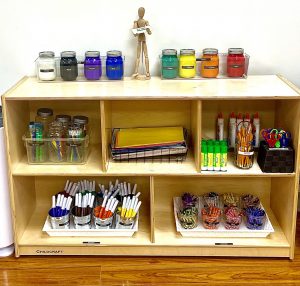
Art is often misunderstood or underappreciated as a vital component of learning. Some may view art as an extra-curricular activity or mere creative play, not realizing its significant contributions to a child’s development. However, we firmly believe that art is not just about drawing or painting; it is about the creative process and fostering imagination.
For instance, art and creativity are fundamental to engineering. Engineers need to think outside the box, innovate, and find solutions to complex problems. Art allows children to think creatively, develop original ideas, and view challenges from various perspectives, which are essential skills for future engineers.
Art is also a process-oriented activity rather than a product-oriented one. It encourages children to explore their imagination, experiment with different materials, and express themselves freely. The act of creating art builds fine motor skills as children learn to hold crayons and paintbrushes. Through art, they learn to communicate their thoughts and emotions, developing their language and self-expression abilities.
At Alpha’s Discovery Kids, we emphasize the importance of providing opportunities for children to engage in art freely. There should be no pressure to create a specific end product; instead, we focus on allowing children to explore and experiment with materials independently. Art is about letting go, embracing creativity, and embracing the joy of the process itself.
There are countless art ideas that children can explore, from painting and drawing to molding and collage-making. We provide various materials, such as markers, child-safe scissors, paint, glue, feathers, and pompoms, to ignite children’s imagination and creativity. By providing open-ended materials, we empower children to choose how they want to participate and let their creativity flow.
We also integrate art with other STEAM components to create a multidimensional learning experience. For instance, while making an animal out of clay (art), we can build the animal’s home (engineering), learn about its characteristics (science), find pictures of the animal on the computer (technology), and measure its size (math). This interdisciplinary approach enhances children’s understanding and application of knowledge. You can find out more about how to incorporate art into STEAM in Susie’s book, Learn To Play.
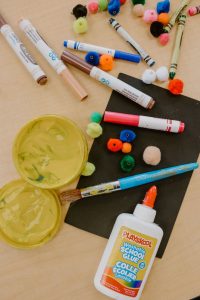
Art is not just crafts; it goes beyond following instructions and specific outcomes. We emphasize the process of making art, encouraging children to explore different materials and techniques. For instance, instead of merely painting on paper, we might encourage children to paint with a straw on a cardboard box, adding multiple dimensions to the experience.
Incorporating the Arts into STEAM education allows us to nurture creativity, self-expression, and problem-solving skills in children. It sets the stage for future innovation and exploration, fostering a love of learning that lasts a lifetime. At Alpha’s Discovery Kids, we celebrate art as a vital aspect of our holistic approach to education, empowering children to become confident, creative, and compassionate individuals.
For more information on our Four Pillars of Learning, or to book a tour, please contact us at https://www.alphasdiscoveryclub.com/contact/ or call us at 905-823-8257.
Engineering in the Early Years
Four Pillars Of Learning – Pillar #2 – STEAM (Engineering edition)
by Susie Beghin, RECE, Founder of Alpha’s Discovery Kids
My mission has always been to provide children with the best possible start in life and help them develop the critical skills they need to thrive.
When I began writing my book, ‘Learn To Play,’ my primary goal was to use the experiences and knowledge I have gained as an ECE educator and mother. It was also a way for me to document our daycare curriculum and make it accessible to parents everywhere!
The Four Pillars of Learning is a comprehensive program that addresses a child’s physical, cognitive, social, emotional, and spiritual well-being. It comprises Language & Literacy, STEAM (Science, Technology, Engineering, Art, and Math), Physical Activity & Nutrition, and Mindful Awareness.
At Alpha’s Discovery Kids, these pillars are prominently displayed in every classroom across our three locations, and our goal is to ensure children have access to a well-rounded education while learning in a meaningful (and fun) way.
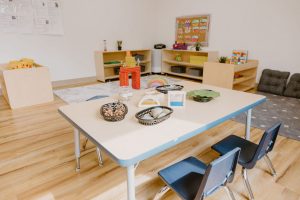
Pillar 2 – STEAM – E is for Engineering
One of the pivotal parts of STEAM is engineering, but when people hear the term ‘engineering,’ they often think it’s something that young children cannot do. However, I use the term intentionally because engineering is precisely what these children do. “Engineering is the process by which young children discover how things in their world are built, and how they work”.
One of the ways we teach engineering in our classrooms is through dedicated and specific areas for construction and building activities. In my last blog, we detailed the integral part that loose parts play in children using their creativity and imagination while learning.
And alongside loose parts, we incorporate materials such as blocks, which hold a special place in my heart. The reason I love blocks is that they are open-ended and allow children to create anything they desire, promoting imagination and creativity. In engineering in our classrooms, we have and use blocks of all sizes, which encourage stacking, sorting, connecting, and disconnecting.
When children engage in engineering activities, they often gravitate towards building tall towers. There is a sense of accomplishment in constructing something tall, even if it only lasts for a few seconds before being knocked down. Both the act of building and knocking down are significant learning experiences, as it allows children to explore concepts of balance, size, and structure as they figure out how to make their towers taller and more stable.
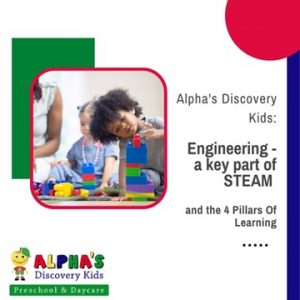
In engineering, we also shift our focus from the end product to the process itself. Instead of dictating what children should create, we provide them with materials and let them decide how to use them. The learning lies not in making a specific object but in gaining insights into size, balance, and cooperation. Engineering becomes a cooperative activity where children work together, negotiate, and problem-solve as they construct and interact with their creations.
The construction area of our classrooms also serves as a hub for social skill development. Children learn to collaborate with their peers, navigate conflicts, and share ideas. They face situations where they need to communicate their preferences and make decisions collectively. It’s an environment that fosters cooperation and encourages children to develop essential social and emotional skills.
The construction area is often our classrooms’ most popular and well-utilized space. Children are drawn to the joy of building and creating. It is a place where their imaginations come alive, they have the freedom to experiment, and they can engage in hands-on learning experiences. As a result, we allocate significant space to this area, recognizing its importance in promoting exploration, creativity, and problem-solving.
Through our focus on engineering, we strive to instill a sense of wonder and curiosity in children. We want them to understand that the process of building and creating is just as valuable as the end result. By embracing engineering in early childhood education, we provide children with opportunities to develop critical thinking skills, expand their imaginations, and foster cooperative relationships.
At Alpha’s Discovery Kids, we are committed to cultivating a love for learning and empowering children to become lifelong learners. Our Four Pillars of Learning, including the exploration of engineering through STEAM, form the foundation of our curriculum. Through these pillars, we create an environment where children can grow, explore, and discover their talents.
For more information on our 4 Pillars of Learning, or to book a tour, please contact us at https://www.alphasdiscoveryclub.com/contact/ or call us at 905-823-8257.
Young Children and Technology
Young Children and Technology
by Susie Beghin, RECE, Founder of Alpha’s Discovery Kids
At Alpha’s Discovery Kids, we recognize the world is an ever-changing place. And with technology continuing to evolve in leaps and bounds, our young children are even more technologically advanced than we could have ever imagined.
This is part of the reason why I wrote my book, ‘Learn To Play’. I wanted to share my knowledge and learnings that I have personally acquired during my time as an ECE educator and a mother. It is important that I share what I know about how children learn with other parents.
At Alpha’s Discovery Kids, we teach kids using our 4 Pillars of Learning curriculum in a way that is playful and fun. Our 4 Pillars of Learning include: Language & Literacy, STEAM (Science, Technology, Engineering, Art and Math), Physical Activity & Nutrition and Mindful Awareness. When I was developing the 4 Pillars, I wanted to ensure I created a program that meets a child’s needs from physical, cognitive, social, emotional and spiritual well-being.
In this article, I want to focus on technology and how it can play a valuable role in young children’s development.
Technology (the second part of STEAM)
Technology is at the core of mostly everything we do nowadays. When we hear the word “technology,” the first thing that often comes to mind is screen time. However, at our daycare, technology is so much more than that. We embrace technology as a tool that enhances learning, fosters parent involvement, and creates exciting opportunities for children to explore the world around them.
Technology as a Resource Tool:
In our classrooms, we utilize iPads as resource tools, opening up a world of knowledge to young minds. For example, when learning about the solar system, we can access captivating videos that visually depict the planets, enabling us to teach complex concepts in an engaging and interactive manner. Technology becomes a catalyst for exploration and discovery, enhancing the learning experience for our children.
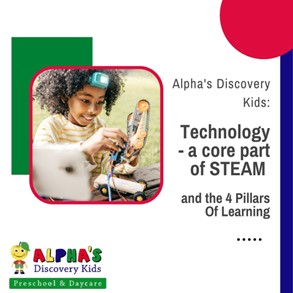
Connecting with Experts and Resources:
Through technology, we have access to a wealth of experts and resources. Whether it’s inviting guest speakers via video conferences or conducting virtual field trips, we can bring diverse perspectives and experiences directly into our classrooms. Technology enables us to expand our horizons and expose children to a vast array of knowledge and expertise.
Communication and Parent Involvement:
One of the most remarkable benefits of technology in our daycare is the ability to record and share children’s daily activities. Through our app, HiMama, we capture videos, photos, and data, documenting each child’s progress, meals, sleep patterns, bathroom breaks, and educational milestones. This instant and real-time information empowers parents to stay involved in their child’s daily life, creating a strong connection between the daycare and home.
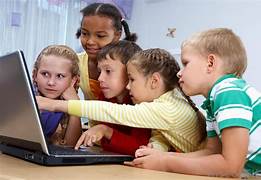 Research and Exploration:
Research and Exploration:
Technology serves as a gateway to endless knowledge. When children have questions or curiosities, we can use technology to conduct research together. For instance, if we want to delve into the fascinating world of polar bears, we can easily access factual information, statistics, and even watch videos about their habitats and behaviors. This interactive approach instills a love for learning and nurtures children’s natural curiosity.
Creativity and Play:
Technology also has a role in fostering creativity and imaginative play. We incorporate music into our classrooms, utilizing technology to play songs and create a lively atmosphere. Additionally, we encourage children to explore their creativity by using technology to record and produce their own little videos, allowing them to express themselves and share their experiences with others.
At Alpha’s Discovery Kids, technology is not a mindless tool for entertainment; it is a purposeful and valuable asset that enriches the learning environment and strengthens the bond between parents, children, and educators.
We harness the power of technology to empower children, promote active learning, and create a sense of involvement and collaboration among parents. Technology opens doors to a world of knowledge, ensuring that our children are equipped with the skills and curiosity needed to thrive in the digital age.
By combining multiple aspects of STEAM every single day, our educators at Alpha’s Discovery Kids are able to teach multiple concepts in one lesson. And STEAM is a pivotal part of this learning.
For more information on our 4 Pillars of Learning, or to book a tour, please contact us at https://www.alphasdiscoveryclub.com/contact/ or call us at 905-823-8257.

